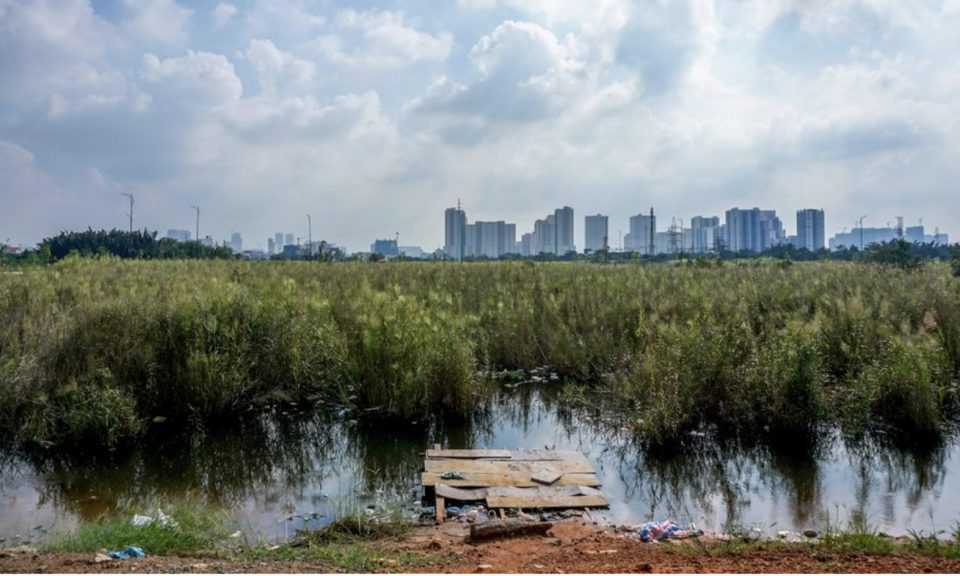Vietnam’s financial hub dream stuck in the mud
01 September, 2018

Look out Singapore, Hong Kong here we come. Vietnam is putting Asia’s top business centers on notice as it bids to establish itself as a financial hub for Southeast Asia.
At least that is how Vietnamese officials tout Thu Thiem, the erstwhile swamp district of Ho Chi Minh City on which they have pinned their skyscraper-filled dreams.
Urban planners have visions of grandeur for Thu Thiem, which they aim to transform into a glistening, steel-laden business hub that bankrolls the wider region’s fast growth.
The catch: the scheme’s official cheerleaders have been touting the transformative central plan for over two decades, so far to no avail. A recent visit to the mega-project’s “New Urban Area” site shows little progress beyond tracts of flattened dirt.
Since the scheme was first conceived, locals have neither complained nor questioned the ruling Communist Party’s ambition to transform Ho Chi Minh City’s marshlands into Southeast Asia’s equivalent of Wall Street.
One marketing brochure rendering of what Thu Thiem will one day become. Photo: Facebook
In the 1990s, Thu Thiem, which juts out from a peninsula just east of Ho Chi Minh City’s downtown, was infested with typhoid and wild animals.
Despite official plans and decades of fast economic growth, little has changed in the area. Just five years ago it was possible to cross the Saigon River to Thu Thiem and go fishing among the tall green reeds while taking in the view of downtown’s skyline from across the water.
It had the feel of a forest in the city, where goats and pigs continued to graze behind the string of neon-green Heineken beer and other advertising billboards. It has since been bulldozed and cleared, but there is still no sign of building cranes.
While there are an estimated 10 million people crammed into Ho Chi Minh City, Thu Thiem remains a vacant space literally a stone’s throw from the bustling city’s center. The unrealized scheme’s architects at least knew where to look for inspiration: the United Kingdom.
Specifically, they found a kindred spirit in Canary Wharf, once a mighty London port that fell into disuse by the 1980s but was given a second lease on life after reinventing itself as a modern financial district.
Ho Chi Minh City started dispatching planners and appartachiks to London for study tours, with at least one of the trips bankrolled by the United Kingdom’s Foreign Office in 2014, to meet the Canary Wharf Group, the reimagined port’s main developer.
People walk to work at London’s Canary Wharf business district. Photo: AFP Forum
“We believe that Thu Thiem … will learn a great deal from the expertise and experience Canary Wharf Group has to offer,” British consul general in Ho Chi Minh City Douglas Barnes said at the time, “whereby they can formulate an action plan to apply what they learn on the development of Thu Thiem.”
He added that the Vietnamese city had been chosen after multiple requests for similar consultations from megacities around the world.
While verdant thickets have given way to steamrollers, Thu Thiem remains nearly devoid of buildings. Locals are no strangers to construction delays, but even by Vietnam’s laggard standards the project has dragged on interminably.
That’s in part due to relocation concerns, an increasingly sensitive issue amid rising complaints of state land-grabbing. Roughly 14,600 households are scheduled to be or have already been forcibly evicted in a “mass dispossession,” according to Yale anthropologist Erik Harms, whose 2016 book “Luxury and Rubble” focuses in part on Thu Thiem.
Many have complained about paltry land compensation. “I once said directly to the people responsible at the city, why demolish the people’s houses like this?” Vo Viet Thanh, a retired vice mayor who helped plan Thu Thiem, said in an interview with news site Zing. “I know that people are protesting…If it were me, I would oppose you, too.”
The saga doesn’t end there, however. Earlier this year local media reported that an early map of Thu Thiem’s master plan had gone missing. Some local officials now say it never existed; others claim the city lost it.
The map is vital because, as plans have changed over the decades, it is needed to determine the rights and payments due to residents based on how the original project lines were drawn and approved.
Aerial view of Thu Thiem district and the Saigon River. Photo: Facebook
More secure are the landed elites who were able to grab up property at early-bird prices, from relatives of former heads of state to well-connected real estate developers. Yet questions have emerged about who was allowed to make land purchases and when.
Public discontent over the lack of transparency grew such that the Ho Chi Minh City government this summer finally announced a public auction of future assets, including nine new plots of land on prime real estate.
With that controversy, Thu Thiem is still mostly unoccupied today, apart from a discarded couch used for makeshift cafe seating on the riverbank or the occasional motorbike cutting through the area for a shorter commute from downtown.
It still seems inevitable that the master plan for the area will ultimately be realized, including designs for the country’s tallest building. Indeed, even the holdouts who have yet to be evicted are not wholly against the project, Harms said in an interview on his university website.
For his research, Harms spoke to dozens of locals there who welcome Thu Thiem’s progress, but they want to be included, not left behind.
“The elite in Vietnamese society [should] recognize that their aspirations for modernization and development, and what they call civility, are often founded on the deep sacrifices of their own countrymen,” Harms wrote.
TAG(s):
